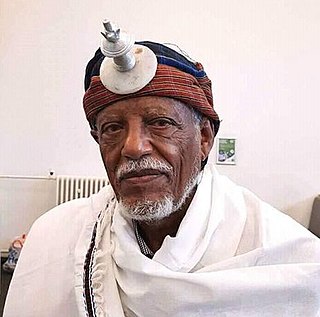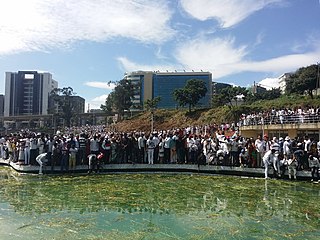 W
WThe culture of Ethiopia is diverse and generally structured along ethnolinguistic lines. The country's Afro-Asiatic-speaking majority adhere to an amalgamation of traditions that were developed independently and through interaction with neighboring and far away civilizations, including other parts of Northeast Africa, the Arabian Peninsula, India, and Italy. By contrast, the nation's Nilotic communities and other ethnolinguistic minorities tend to practice customs more closely linked with South Sudan and/or the African Great Lakes region.
 W
WA coffee ceremony is a ritualized form of making and drinking coffee. The coffee ceremony was first practiced by the southwestern Ethiopian people. There is a routine of serving coffee daily, mainly for the purpose of getting together with relatives, neighbors, or other visitors. If coffee is politely declined, then tea will most likely be served.
 W
WThe dabqaad, also known as unsi or girgire, is an incense burner, or censer. With either one or two handles, it is commonly used in Somalia, Somaliland and Djibouti.
 W
WEnkutatash is a public holiday in coincidence of New Year in Ethiopia and Eritrea. It occurs on Meskerem 1 on the Ethiopian calendar, which is 11 September according to the Gregorian calendar.
 W
WEthiopian art from the 4th century until the 20th can be divided into two broad groupings. First comes a distinctive tradition of Christian art, mostly for churches, in forms including painting, crosses, icons, illuminated manuscripts, and other metalwork such as crowns. Secondly there are popular arts and crafts such as textiles, basketry and jewellery, in which Ethiopian traditions are closer to those of other peoples in the region. Its history goes back almost three thousand years to the kingdom of D'mt. The Ethiopian Orthodox Tewahedo Church has been the predominant religion in Ethiopia for over 1500 years, for most of this period in a very close relation, or union, with the Coptic Christianity of Egypt, so that Coptic art has been the main formative influence on Ethiopian church art.
 W
WEthiopian crosses are symbols of Christianity in Ethiopia and Eritrea. Their elaborate, stylized design is markedly distinct from the similar European Christian crosses. Ethiopian crosses are almost always made from elaborate latticework, the intertwined lattice represents everlasting life. No two crosses are exactly identical in style, the artisans who make them being allowed the freedom to exercise a measure of individual taste and creativity in their choice of shape and pattern. Crosses may be of the processional type with a socket at the base so they may be mounted on a staff and carried in church ceremonies or hand-held blessing crosses used by priests in benedictions.
 W
WA number of different units of measurement have been used in Ethiopia. The values of most of these units are not well defined. In 1963, Ethiopia adopted the metric system.
 W
WGadaa is the indigenous democratic system of governance used by the Oromos in Ethiopia and northern Kenya. It is also practiced by the Konso and Gedeo people of southern Ethiopia. The system regulates political, economic, social and religious activities of the community.
 W
WIrreecha, is thanksgiving holiday of the Oromo people in Ethiopia. The Oromo people celebrate Irreecha to thank Waaqa (God) for the blessings and mercies they have received throughout the previous year. The Irreecha festival is celebrated every year at the beginning of Birraa (Spring), new season after the dark and rainy winter season. It is attended by hundreds of thousands people. The thanksgiving is celebrated at sacred lakes across Oromia and Hora Harsadi, Bishoftu, Oromia as a whole. Once at the lake, festival-goers immerse the green grass and the flowers they are carrying and sprinkle themselves.
 W
WThe Kebra Nagast, var. Kebra Negast, or The Glory of the Kings, is a 14th-century national epic account written in Ge'ez by Is'haq Neburä -Id of Axum. The text, in its existing form, is at least 700 years old and is considered by many Ethiopian Christians to be a historically reliable work. It is considered to hold the genealogy of the Solomonic dynasty, which followed the Ethiopian Orthodox Church.
 W
WThe Konso, also known as the Xonsita, are a Lowland East Cushitic-speaking ethnic group primarily inhabiting south-central Ethiopia.
 W
WThe Lalibela Cross is a large, elaborately decorated processional cross, considered one of Ethiopian most precious religious and historical heirlooms. It is held by the Bet Medhane Alem, the House of the Redeemer of the World, a 12th-century rock-cut church in Lalibela. A priest may rub believers with the cross to bless them or heal them. The style of the cross was common in its time and those of this style are often simply referred to today as "Lalibela crosses".
 W
WThe National Archives and Library of Ethiopia, located in Addis Ababa, is the national library and archives of the country. The library was inaugurated in 1944 by Emperor Haile Selassie and began service with books donated by the emperor.
 W
WSenterej is a regional chess variant, the form of chess traditionally played in Ethiopia and Eritrea. It is the last popular survival of shatranj. A distinctive feature of Senterej is the opening phase – players make as many moves as they like without regard for how many moves the opponent has made; this continues until the first capture is made. Memorization of opening lines is therefore not a feature of the game.
 W
WA shotel is a curved sword originating in Ethiopia and Eritrea. The curve on the blade varies from the Persian shamshir, adopting an almost semicircular shape. The blade is flat and double-edged with a diamond cross-section. The blade is about 40 inches (1,000 mm) in total length and the hilt is a simple wooden piece with no guard. The shotel was carried in a close fitting leather scabbard.
 W
WIn northern Ethiopia, the home-brewed siwa (Ge'ez: ሰዋ, romanized: säwa) strongly resists the rise of lager beers. The traditional siwa remains the topper during social events, after (manual) work, and as an incentive for farmers and labourers. Thousands of traditional beer houses straddle the Tigrayan urban and rural landscapes.
 W
WSports in Ethiopia include many fields, although Ethiopia is best known internationally for its middle-distance and long-distance runners. Seifu Mekonnen was an Olympic contestant for Ethiopia in boxing. The Ethiopian national football team won the 1962 African Cup of Nations. There are also traditional sports events, such as stick fighting which is popular amongst the Surma and Nyangatom people.
 W
WTSEHAI Publishers is an independent, academic press based at Loyola Marymount University in Los Angeles, California. It has various imprints, and is run by its founder, exiled Ethiopian journalist and publisher Elias Wondimu.